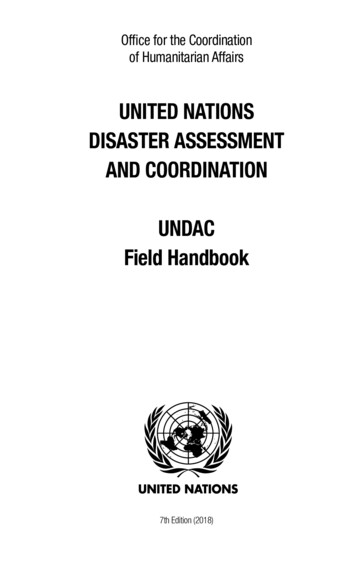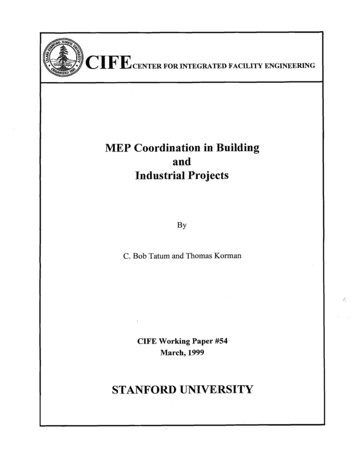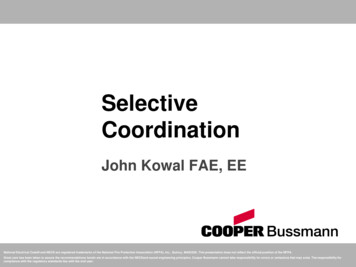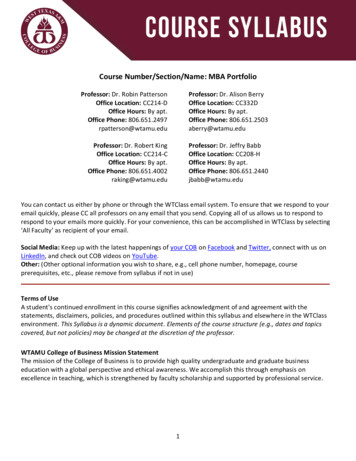
Transcription
Office for the Coordinationof Humanitarian AffairsUNITED NATIONSDISASTER ASSESSMENTAND COORDINATIONUNDACField Handbook7th Edition (2018)
UNDAC Handbook 2018TABLE OF CONTENTSPREFACEForewordIntroduction to the HandbookHOW TO CONTACT OCHABACKGROUNDA. THE INTERNATIONAL EMERGENCYENVIRONMENTA.4.7 Private sectorA.4.8 Ad hoc and improvisedhumanitarian groupsA.4.9 DiasporaA.1 IntroductionA.1.1 Tenets of international emergencyresponseA.1.2 Recent developmentsA.2 Humanitarian responsemechanismsA.2.1 The GovernmentA.2.2 The Emergency Relief Coordinator(ERC) and OCHAA.2.3 The Inter-Agency StandingCommittee (IASC)A.2.4 The UN Resident Coordinator (RC)and the Humanitarian Coordinator(HC)A.2.5 The Humanitarian Country Team(HCT)A.3 Humanitarian coordinationA.3.1 Humanitarian coordinationstructures and the ClusterApproachA.3.2 Field level coordination structuresA.3.3 The Humanitarian ProgrammeCycle (HPC)A.3.4 The Central Emergency ResponseFund (CERF)A.3.5 Humanitarian Response Plans(HRPs) and Flash AppealsA.4 Stakeholders in internationaldisaster responseA.4.1 Civil society and GovernmentA.4.2 UN AgenciesA.4.3 The Red Cross and Red CrescentMovementA.4.4 Non-Governmental Organizations(NGOs)A.4.5 International GovernmentalOrganizations (IGOs)A.4.6 Military forcesB. THE UNDAC CONCEPTB.1 IntroductionB.1.1 ComponentsB.1.2 ConceptB.1.3 Core activitiesB.1.4 UNDAC Standard Terms ofReference (ToR)B.2 UNDAC methodologyB.2.1 The CornerstonesB.3 The UNDAC systemB.3.1 System membershipB.4 Team membershipB.4.1 FunctionsB.4.2 Qualifications and trainingB.4.3 The wider UNDAC networkB.5 UNDAC supportB.5.1 Mobilization of support servicesB.5.2 UNDAC operational partnersC. PRE-MISSIONC.1 IntroductionC.2 PreparednessC.2.1 Medical preparednessC.3 MobilizationC.3.1 UNDAC Mission Software (UMS)C.3.2 Plan of Action (PoA)D. ON-MISSIOND.1 IntroductionD.2 ArrivalD.2.1 Initial meeting with the RC/HC, theHCT, and the national authoritiesiii
UNDAC Handbook 2018D.3 ExecutionD.3.1 ConsolidationI. ASSESSMENT AND ANALYSIS (A&A)E. MISSION ENDI.2 Assessment coordination andanalysis strategyI.2.1 Internal analysis set-up and A&ACellI.2.2 Assessment coordination (externalset-up)I.2.3 Planning for data collection andconsolidation (analysis plan)I.2.4 Multi-Cluster/Sector Initial RapidAssessment (MIRA)I.3 Data collectionI.3.1 Secondary Data Review (SDR)I.3.2 Primary data collectionI.3.3 Primary data collection methodsI.4 ProcessingI.4.1 Data cleaningI.5 AnalysisI.5.1 Analysis modelsI.5.2 Analytical stepsI.5.3 Analytical toolsI.5.4 Shared analysisI.1 Assessment and Analysis basicsE.1 IntroductionE.2 Handover and exitE.2.1 Mission reportingE.2.2 DebriefE.2.3 Administrative mattersF. TEAM MANAGEMENTF.1 Team functioningF.1.1 Team developmentF.1.2 Team coordinationF.2 Team leadership and managementF.2.1 Situational leadershipF.2.2 UNDAC collective leadershipF.2.3 Internal coordinationF.2.4 Managing interpersonal relationsF.3 Guide for UNDAC Team LeadersG. SAFETY AND SECURITYG.1 IntroductionJ. REPORTING AND ANALYTICALOUTPUTSG.2 UN security management systemG.3 Security Risk Management (SRM)G.3.1 The Security Risk Management(SRM) ProcessG.3.2 Programme CriticalityG.4 Security-related responsibilities:UNDAC Team LeaderJ.1 ReportingJ.1.1 Standard UNDAC productsJ.1.2 Visualizing dataJ.2 Analytical outputsJ.2.1 Geospatial Information Services(GIS)G.5 Security-related responsibilities:UNDAC Team MembersG.5.1 Personal safety and securityK. MEDIAH. INFORMATION MANAGEMENTPLANNINGH.1 The information landscapeH.2 Information management strategyH.2.1 Folder structures and namingconventionsK.1 Contact with mediaK.1.1 Key media messagesK.1.2 Working with UN and OCHA PublicInformation OfficersK.2 Social mediaK.2.1 Role of the UNDAC teamL. COORDINATIONL.1 Introductioniv
UNDAC Handbook 2018L.2 Coordination methodologyL.2.1 Coordination techniquesL.2.2 Meeting managementL.2.3 Coordination barriersL.3 Humanitarian Programme Cycle(HPC) supportL.3.1 Inter-cluster coordination (ICC)L.3.2 Protection considerationsL.3.3 Cash transfer programming (CTP)L.3.4 Private sector engagementL.3.5 Humanitarian response planningand financingL.3.6 Community engagementL.3.7 Gender equality programming inhumanitarian actionN.4 Civil-Military Coordination(CMCoord)N.4.1 UNDAC and UN-CMCoordN.4.2 UN-CMCoord assessmentN.4.3 Military customs and courtesiesN.4.4 UN-CMCoord referencesO. REGIONAL APPROACHESM.2 The OSOCC conceptM.2.1 OSOCC purposeM.2.2 OSOCC contextM.2.3 OSOCC structureM.3 OSOCC functions and cellsM.3.1 The Management FunctionM.3.2 Situation FunctionM.3.3 Operations FunctionM.3.4 Support FunctionM.4 OSOCC facilitiesM.4.1 Establishing facilitiesM.4.2 Maintaining facilitiesM.4.3 Facility demobilizationM.5 Reception & Departure Centre(RDC)M.5.1 RDC coordinationO.1 AfricaO.1.1 Regional emergency responsemechanismsO.1.2 Regional arrangementsO.2 AmericasO.2.1 Regional emergency responsemechanismsO.2.2 SOPs between the United Nations(OCHA/UNDAC) and CDEMAO.3 AsiaO.3.1 Regional emergency responsemechanismsO.3.2 SOPs between the United Nations(OCHA/UNDAC) and the AHACentre/ERAT teamsO.3.3 Regional arrangementsO.4 EuropeO.4.1 Regional emergency responsemechanismsO.4.2 SOPs between the United Nations(OCHA/UNDAC) and ECHOO.5 PacificO.5.1 Regional emergency responsemechanismsO.5.2 SOPs between the United Nations(OCHA/UNDAC) and the PHTO.5.3 Regional arrangementsN. COORDINATION CELLSP. DISASTER LOGISTICSN.1 IntroductionP.1 IntroductionM. OSOCC CONCEPTM.1 IntroductionN.2 Urban Search and Rescue (USAR)N.2.1 The USAR Coordination Cell (UCC)N.2.2 USAR assessmentsN.2.3 Demobilization of USAR teamsN.3 Emergency Medical Teams (EMTs)N.3.1. Emergency Medical TeamsN.3.2 EMT Coordination Cell (EMTCC)N.3.4 EMT coordination steps and therole of the UNDAC teamP.2 OverviewP.3 Logistics roles and responsibilitiesP.3.1 The United NationsP.3.2 National authoritiesP.4 Planning a logistics programmeP.4.1 The planning processP.5 The Logistics Clusterv
UNDAC Handbook 2018Q. ICT AND TECHNICAL EQUIPMENTT. REFERENCESQ.1 Phones and dataQ.1.1 Handheld satellite telephonesQ.1.2 Satellite data terminalsQ.1.3 Personal laptopsQ.1.4 Mobile phonesQ.2 RadiosQ.2.1 Radio systemsQ.2.2 General radio proceduresQ.2.3 Radio terminologyQ.3 Global Positioning System (GPS)Q.3.1 Coordinates and datumsQ.3.2 Waypoints and tracksT.1 Conversion tables (imperial andmetric)R. FACILITIEST.6 Phonetic alphabet, standard UNcall signs and radio prowordsR.1 Designing an OSOCC facilityT.7 Sources of secondary dataR.2 Base campR.2.1 Site selection checklistR.2.2 Camp constructionT.8 Protection mainstreamingactivities by sectorT.2 Characteristics of aircraftcommonly used duringemergenciesT.3 Characteristics of helicopterscommonly used duringemergenciesT.4 Aircraft loading and offloadingmethodsT.5 AcronymsS. PERSONAL HEALTHS.1 Staying healthy on missionS.1.1 Pre-deploymentS.1.2 During the missionS.1.3 After the missionS.2 Food and waterS.2.1 FoodS.2.2 WaterS.2.3 Managing diarrhoeaS.3 Managing mission stressS.3.1 Cumulative stressS.3.2 Critical incident stressS.4 Medical emergencies and first aidvi
UNDAC Handbook 2018PREFACEForeword. viiIntroduction to the Handbook. viiHow to contact OCHA. ixOCHA Geneva.ixOCHA New York.ixUNDAC mobilization and missions.ixForewordThis 7th edition of the UNDAC Field Handbook 2018 marks the 25th anniversary of theUnited Nations Disaster Assessment & Coordination system (UNDAC). The UNDAC systemwas originally established by United Nations (UN) and the International Search and RescueAdvisory Group (INSARAG) to ensure effective coordination between national disastermanagement agencies and incoming search and rescue teams in sudden-onset, largescale emergencies. Over the past quarter of a century, UNDAC has evolved and adaptedto the changing requirements of the international humanitarian response system. Today,UNDAC teams are not only deployed in sudden-onset disasters, but also provide valuablesupport in protracted crises, technological and other types of emergencies, and are playingan increasing role as a tool and service of the UN in supporting governments in disasterresponse preparedness activities. UNDAC deploys globally to ensure effective collaborationbetween national disaster management systems, international humanitarian responseactors, bilateral responders including the military, national non-government organizations,civil society and the private sector, to name but a few.Core to UNDAC practices is systematic post-mission evaluation to enable best practicesand lessons learned to feed into the continuous development of the UNDAC methodologycaptured in this updated Handbook. This is, therefore, a living document and, as a readerand user, you should consider yourself a co-creator. Comments or suggestions for furtherdevelopment of the Handbook should be addressed to the Emergency Response SupportBranch (ERSB) in OCHA Geneva.Introduction to the HandbookThe UNDAC Field Handbook is intended as an easily accessible reference guide formembers of an UNDAC team before and during a mission to a disaster or emergency.The Handbook is not an authoritative instruction, but rather represents an accumulation ofinstitutional memory related to processes and procedures for coordination as seen in thescope of the UNDAC Standard Terms of Reference. Its focus is on both the what and thehow of international emergency response and is grounded in the mandate of the UN Officefor the Coordination of Humanitarian Affairs (OCHA), which manages the UNDAC system.vii
UNDAC Handbook 2018The Handbook is divided into six main themes that are broadly aligned with the functions ofan On-Site Operations Coordination Centre (OSOCC). Each theme is divided into chaptersthat are written as stand-alone documents, referencing material across all themes.THEMESCHAPTERSThe UNDAC Handbook has been developed by OCHA with support from members of theinternational UNDAC system. Information is drawn from a wide variety of sources: UNDAC best practices as captured in mission reports and training materials.Various OCHA, UN and Inter-Agency Standing Committee (IASC) guidelines, e.g.INSARAG Guidelines, Multi-Sector Initial Rapid Assessment (MIRA) Guidance, andnumerous others.The United Nations High Commissioner for Refugees (UNHCR) Operational DataManagement Learning Programme.The United States Office of Foreign Disaster Assistance (OFDA) Field OperationsGuide and Disaster Assessment Procedures Manual.Publications by the International Federation of Red Cross and Red Crescent Societies(IFRC).Humanitarian Practice Network (HPN) paper Common Needs Assessments andhumanitarian action.Technical briefs and training material from the Assessment Capacities Project (ACAPS).ACAPS and the Emergency Capacity Building Project (ECB) Humanitarian NeedsAssessment – The Good Enough Guide.Disaster Management research from Lund University, Sweden and University ofCopenhagen, Denmark.OCHA is grateful for these contributions in support of the UNDAC system.viii
UNDAC Handbook 2018HOW TO CONTACT OCHAOCHA GENEVAEmergency Response Support Branch (ERSB)United Nations Office at GenevaPalais des NationsCH-1211 Geneva 10SwitzerlandDuring Office Hours (08:00 – 18:00 CET): 41 22 917 1234 (switchboard)Email: --OCHA NEW YORKUnited Nations Headquarters1 United Nations PlazaNew York, NY 10017USADuring Office Hours (08:00 – 18:00 EST): 1 (212) 963 1234 (switchboard)Email: -UNDAC MOBILIZATION AND MISSIONSIn emergencies when an UNDAC team is mobilized by OCHA Geneva, two separate lines ofcommunication will be opened exclusively for direct contacts with the Emergency ResponseSupport Branch (ERSB):Phone: 41 22 917 1600Email: undac alert@un.orgix
BACKGROUNDBefore deploying on an UNDAC mission, you need to know some basic information abouthow international emergency response functions, the principles upon which it is founded,and how the UNDAC concept works and fits into the larger system. This theme consists ofthe following chapters:A. The International Emergency EnvironmentThis chapter provides a general background to international humanitarian assistancein disasters, humanitarian response mechanisms and coordination structures, and themost common stakeholders.B. The UNDAC ConceptThis chapter introduces the UNDAC concept, explains the foundations of the UNDACmethodology, how the system works, and introduces UNDAC operational partners andsupport services.
UNDAC Handbook 2018A. THE INTERNATIONAL EMERGENCY ENVIRONMENTA.1 Introduction.1A.1.1 Tenets of international emergency response.2A.1.2 Recent developments.4A.2 Humanitarian response mechanisms.4A.2.1 The Government.5A.2.2 The Emergency Relief Coordinator (ERC) and OCHA.5A.2.3 The Inter-Agency Standing Committee (IASC).6A.2.4 The UN Resident Coordinator (RC) and the Humanitarian Coordinator (HC).6A.2.5 The Humanitarian Country Team (HCT) .7A.3 Humanitarian coordination.7A.3.1 Humanitarian coordination structures and the Cluster Approach.7A.3.2 Field level coordination structures.9A.3.3 The Humanitarian Programme Cycle (HPC).12A.3.4 The Central Emergency Response Fund (CERF).12A.3.5 Humanitarian Response Plans (HRPs) and Flash Appeals.13A.4 Stakeholders in international disaster response.13A.4.1 Civil society and Government.13A.4.2 UN Agencies.14A.4.3 The Red Cross and Red Crescent Movement.15A.4.4 Non-Governmental Organizations (NGOs).16A.4.5 International Governmental Organizations (IGOs).17A.4.6 Military forces .17A.4.7 Private sector.18A.4.8 Ad hoc and improvised humanitarian groups.18A.4.9 Diaspora.18A.1 IntroductionA sudden-onset emergency situation is often characterized by overwhelming needs,competing priorities, destroyed or damaged communication and transportation infrastructure,a rapid influx of providers of humanitarian assistance coupled with an outburst of mutualaid from local communities, as well as overwhelmed and highly stressed officials fromgovernmental and non-governmental institutions. Given this view of an emergency, an imageof chaos quickly springs to mind.The opposing view would be one of coordinated activities and structures that bring orderto the chaos. At its best, coordination contributes to humane, neutral, impartial, timely andrelevant assistance, increased management effectiveness, a shared vision of the bestpossible outcomes from a given situation, a seamless approach to service delivery anddonor confidence resulting in sufficient resources to achieve the desired outcomes, i.e., theleast possible amount of human suffering and material damage, seamless recovery and arapid return to normal living conditions and the ongoing progress of development.Page 1 of 18A
UNDAC Handbook 2018There are some fundamental tenets that define the framework of international emergencyresponse and influence coordination of humanitarian assistance. This chapter providesUNDAC members with an introduction to principles, authorities, frameworks and the generalcontext which govern international humanitarian response.A.1.1 Tenets of international emergency responseInternational emergency response is humanitarian assistance to a crisis-affected populationthat seeks, as its primary purpose, to save lives and alleviate suffering. Humanitarianassistance is deeply rooted in history and culture, from ethno-religious beginnings and postwar interventions to the ‘modern’ era of humanitarianism. Considered as the desire to lendassistance to others, humanitarian action is as old as humanity itself.The UN was established on 24 October 1945 by 51 countries committed to preservingpeace through international cooperation and collective security. Today, nearly every nationin the world belongs to the UN and membership totals 193 countries. When States becomemembers of the United Nations, they agree to accept the obligations of the UN Charter,an international treaty that sets out basic principles of international relations. Accordingto the Charter, the UN has four purposes: to maintain international peace and security; todevelop friendly relations among nations; to cooperate in solving international problems andin promoting respect for human rights; and to be a centre for harmonizing the actions ofnations. The UN Charter, Article 1.3, mentions humanitarian assistance, in particular, whereit defines that one of the UN’s purposes is “to achieve international co-operation in solvinginternational problems of an economic, social, cultural, or humanitarian character, and inpromoting and encouraging respect for human rights and for fundamental freedoms for allwithout distinction as to race, sex, language, or religion”.In December 1991, the UN General Assembly (GA) adopted the ground-breaking Resolution46/182 “Strengthening of the coordination of emergency humanitarian assistance of theUnited Nations”, which is the foundation of the international humanitarian system as we knowit today. It laid down the key principles for humanitarian action as well as the ‘architecture’of international humanitarian assistance. Along with the humanitarian principles set forth inthe Geneva Conventions and other international legal frameworks, GA Resolution 46/182continues to shape how humanitarian work is conducted and organized.GA Resolution 46/182 agreed on guiding principles for the Member States and the UN andthe establishment of coordination mechanisms. The Resolution determined the following:1)Humanitarian assistance must be provided in accordance with basic humanitarianprinciples that provide the fundamental foundations for humanitarian action. Humanitarianprinciples are central to establishing and maintaining access to affected populationswhether in the context of a natural disaster, an armed conflict or a complex emergency,i.e., a humanitarian crisis which occurs in a context where there is a total or considerablebreakdown of authority resulting from civil conflict and/or foreign aggression.Promoting compliance with humanitarian principles in humanitarian response is anessential element of effective humanitarian coordination. Humanity – Human suffering must be addressed wherever it is found. The purpose ofhumanitarian action is to protect life and health and ensure respect for human beings. Impartiality – Humanitarian action must be carried out on the basis of need alone,giving priority to the most urgent cases of distress and making no distinctions on thebasis of nationality, race, gender, religious belief, class or political opinions. Neutrality – Humanitarian actors must not take sides in hostilities or engage incontroversies of political, racial, religious or ideological nature.Page 2 of 18
UNDAC Handbook 2018 Independence – Humanitarian action must be autonomous from the political,economic, military or other objectives that any actor may hold with regard to areaswhere humanitarian action is being implemented.2) The sovereignty, territorial integrity and national unity of countries must be respected andinternational assistance can only be provided with the consent of the affected country.The UN Charter, Article 1.3 (see quotation above), describes the overarching UN mandatefor humanitarian coordination; but another fundamental principle is defined in the UNCharter, Article 2, which states that no international organization or country can intervenein another country without consent. The national Government is the absolute authoritywithin the borders of its own territory. As such, the responsibility and authority to assistand meet the needs of a society lies with its own Government. A Government can ask orwelcome assistance from other States or organizations but assistance cannot be forcedupon them unless a majority of the members of the UN Security Council can agree thatthe matter is of such importance that humanitarian assistance must be imposed. Todeploy to another country without being requested and without being welcomed or inother ways invited, can, regardless of intentions, be considered an act of force similar toan invasion and will be considered a violation of international conventions. Consequently,all international assistance is conducted in support of national authorities and uponrequest, irrespective of the desire of international organizations to respond immediately.3)The affected country has the primary lead role in the initiation, organization,coordination and implementation of humanitarian assistance within its territory. Formost natural disasters, the affected State is a willing and legitimate partner anddoes request (or ‘welcome’) international assistance. In more complex emergencies,however, the legitimacy and territory of the State may be in violent dispute. In somesituations, a legitimate Government may not exist and, even if it does, it may havelimited authority and capability. This situation makes adherence to the above principlesproblematic in complex emergencies. In these cases, the commitment to the victimsmay supersede the commitment to the State. More likely, however, coordination effortswill need to acknowledge the legitimacy of competing authorities and humanitarianadvocacy will become a strong focus. Thus, one may need to develop and maintaineffective relationships not only with the State but also with the antagonists, politicalopposition and in some situations, non-state actors.4)At the same time, sovereign States are encouraged to facilitate the implementation ofhumanitarian assistance by intergovernmental and non-governmental organizations,particularly when capacity is lacking.5)The UN play a central and singular role in providing leadership and coordinating theefforts of the international community in support of the affected countries.In line with these principles, no international organization has the authority to tell anotherorganization what to do. The UN is an organization of Member States that works throughconsensus. It is not a world government and it does not make laws. It does, however,provide the means to help resolve international conflicts and formulate policies on mattersaffecting the whole world. Within the UN, all Member States, regardless of size, politicalviews or social systems, have a voice and a vote in this process. As a result, several UNbodies, i.e., departments and offices of the UN Secretariat, specialised agencies, funds andprogrammes, have been given a mandate to provide or coordinate international assistancewithin their field but without any authority to command, direct or order. This is a privilege thatremains with State authorities only.In line with the humanitarian principles, we find the ‘do no harm’ principle which is derivedfrom medical ethics. It requires humanitarian organizations to strive to minimize the harmPage 3 of 18A
UNDAC Handbook 2018they may inadvertently do through their presence in providing assistance. Humanitarianactors need to be aware if assistance is used to reinforce nepotism or corruption, orbecomes a de facto part of the dynamics in a context because it creates jobs, gives incomein the form of taxes, leaves little or no responsibility on the State for social welfare, etc.Such unintended negative consequences may be wide-ranging and extremely complex. Tominimize possible longer-term harm, humanitarian organizations should provide assistancein ways that are supportive of recovery and long-term development.A.1.2 Recent developmentsIn May 2016, the World Humanitarian Summit (WHS), was held in Istanbul, Turkey, aimed atfundamentally reforming the humanitarian aid industry to react more effectively to today’smany crises. The WHS resulted in about 1,500 commitments from 400 UN Member Statesand other organizations. One of the Summit’s main achievements was ‘The Grand Bargain,’which is the name for a set of 51 ‘commitments’ to reform humanitarian financing and makeit more efficient and effective.The Grand Bargain aims to offer one of the solutions to address the humanitarian financinggap. It includes a series of changes in the working practices of donors and aid organizationsthat would deliver an extra billion dollars over five years for people in need of humanitarianaid. These changes include gearing up cash programming, greater funding for national andlocal responders and cutting bureaucracy through harmonised reporting requirements. TheGrand Bargain commits donors and aid organizations to: Greater transparency. More support and funding tools for local and national responders (25% of globalhumanitarian funding by 2020). Increase the use and coordination of cash-based programming. Reduce duplication and management costs with periodic functional reviews. Improve joint and impartial needs assessments. A participation revolution: include people receiving aid in making the decisions whichaffect their lives. Increase collaborative humanitarian multi-year planning and funding. Reduce the earmarking of donor contributions. Harmonise and simplify reporting requirements. Enhance engagement between humanitarian and development actors.It is anticipated that the implementation of the sum of the Grand Bargain commitments willresult in better aid, with humanitarian action moving from a supply-driven model dominatedby aid providers, to a demand-driven model, more responsive to the people being assisted.A.2 Humanitarian response mechanismsIn all disasters requiring international assistance, a range of organizations or entities willprovide relief. These range from national and local authorities, through UN agencies, tointernational and national response organizations. Again, GA Resolution 46/182 providesthe basic architecture for the international humanitarian system. In addition to the abovementioned principles, the resolution established the following: The position of an Emergency Relief Coordinator (ERC), at Under-Secretary-General(USG) level, to coordinate and facilitate humanitarian assistance. The Inter-Agency Standing Committee (IASC) as the primary mechanism tocoordinate the assistance of UN and non-UN humanitarian partners. Under theleadership of the ERC, the IASC develops humanitarian policies, agrees on aPage 4 of 18
UNDAC Handbook 2018clear division of responsibility for the various aspects of humanitarian assistance,identifies and addresses gaps in response and advocates for effective application ofhumanitarian principles. The establishment of the consolidated appeal process and the Central EmergencyResponse Fund (CERF) which can disburse swiftly up to USD 450 million per yearfor sudden-onset emergencies, rapidly deteriorating situations and protracted crisesthat fail to attract sufficient resources. The establishment of the Department of Humanitarian Affairs (DHA) with offices inGeneva and New York to provide institutional support to the ERC/USG. In 1998 DHAwas renamed the Office for the Coordination of Humanitarian Affairs (OCHA).The following sections provide an overview of the primary actors involved in coordination ofinternational emergency response.A.2.1 The GovernmentAs per GA Resolution 46/182, the Government of a disaster-affected country bears theprimary responsibility for humanitarian assistance and coordination. Structures that allowGovernments to manage, prevent and respond to disasters have become increasinglysophisticated and are founded typically upon a civil protection approach with operations usingan incident management system. Most countries will have a National Disaster/EmergencyManagement Authority or Civil Protection Agency to oversee and coordinate risk analysis,preparedness and response, but capacities and capabilities of these agencies may vary.A general framework for coordination within the Government at the capital level is headedby a Minister/Secretary of
The Handbook is not an authoritative instruction, but rather represents an accumulation of . Publications by the International Federation of Red Cross and Red Crescent Societies (IFRC). Humanitarian











